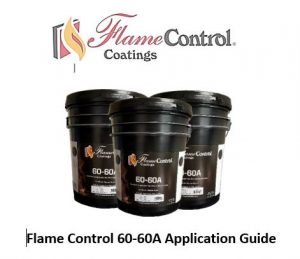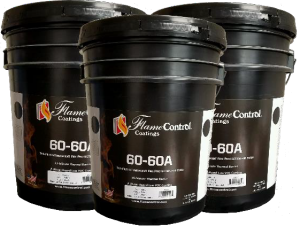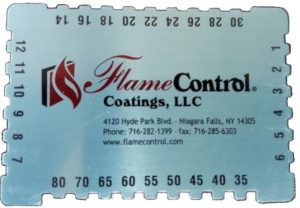Flame Control 60-60A Application Guide

Flame Control No. 60-60A has met the criteria for use as a 15-minute thermal barrier on Spray Polyurethane Foam (SPF). No. 60-60A is a low VOC, water-based intumescent coating that dries to a flat finish.
No. 60-60A was subjected to flammability testing per NFPA 286 and successfully met the criteria listed in the 2006, 2009, 2012, and 2015 International Building Code (IBC) and International Residential Code (IRC)
Flame Control No. 60-60A is approved for use as an alternative thermal barrier per IBC Section 2603.9/IRC R316.6

60-60A is AC-456 Compliant
Evaluation Report: IAPMO ER 596 & Section: 09 96 43 – Fire Retardant Coatings
Surface Preparation:
All surfaces to be painted must be clean and cured. The foam must be firm, dry and free of dust, dirt, oil, wax, grease, and mildew. The quality of any paint job is only as good as the surface preparation that precedes the paint application. Flame Control 60-60A has excellent bonding characteristics and will adhere to most sound, clean, foam surfaces. Make sure the surface of the foam is free of holes, exposed cells, and that the surface is stable and not crumbling or deteriorated. If any defects are found, repair them prior to proceeding.
Mildew should be removed by scrubbing with a 25% solution of household bleach water. Tri-sodium phosphate (TSP) or common laundry powder such as Tide may be added to solution to assist removal.
Temperature:
60-60A is water-based coating which will freeze at temperatures below 32°F. Care should be taken to protect the material from freezing. Should 60-60A freeze, warm the material and thoroughly mix prior to application. It is recommended to store material at temperatures above 50°F. For temperatures below 50°F, refer to the 60-60A cold weather instructions on page 3 of this document. 60- 60A has been subjected to freeze-thaw testing and is suitable for use even if the material has been frozen.
Humidity: When 60-60A is installed in areas of high humidity or unconditioned spaces prone to moisture, a compatible protective topcoat such as Flame Control 400 or Sherwin-Williams A-100 is required.
Important: During Application, humidity 65% and higher must use fans to move air for curing. High humidity may require longer cure times.
Specifications:
| Specifications | |
| Finish | Flat |
| Colors | White, Black, Tints |
| VOC | Less than 40 g/l |
| Flash Point | None |
| Solids | 70% |
| Drying Time @
77°F (25°C) & 50% R.H. |
To Touch: 1 Hour To Topcoat: 4 Hours |
| Shelf Life | 1 Year (Unopened) |
Material Preparation:
60-60A must be thoroughly mixed before application. Failure to do so will compromise the protective capabilities of Flame Control 60-60A. We recommend mechanical stirring with a high-speed drill and a paddle appropriate for the size container. Contents should be stirred to a creamy consistency with no lumps.
60-60A is a water-based product and slight thinning will not hurt the product. It should be noted that thinning increases the likelihood of not applying the proper film thickness, resulting in decreased fire protection capabilities. It is the sole responsibility of the applicator to ensure the proper film thickness has been applied.
60-60A should never be mixed with other materials, however tinting using universal paint tint is acceptable. 60-60A can be tinted up to a maximum of 2 fluid ounces per gallon (10 ounces per 5-gallon pail).
Application Equipment:
60-60A is a unique coating designed specifically for the applicator. The viscosity of 60-60A is designed to be easy to mix and easy to spray while providing good sag resistance to be applied in a single coat
60-60A can be applied by brush, roller or airless sprayer.
Spraying:
Remove all filters from the machine and gun.
Airless Spray Minimum:
PSI: 2500 PSI or higher or equivalent
Hose: 1/4” diameter airless spray line for the first 50’ from pump and ¼” x 6’ whip
Tip: 521 – 527
GPM: .70
For best results use, Hose: 3/8” diameter airless spray line for the first 50’ from pump and ¼” x 6’ whip and no filters in the gun and machine.
Measuring Wet Film Thickness (WFT)
A wet film gauge like the one above can be utilized to determine the mil thickness of the paint film that has just been applied.
To use the WFT gauge, simply place the gauge onto the freshly sprayed area. The gradients will indicate the film thickness that has been applied by visually inspecting what teeth on the gauge have contacted the paint. For Example, if the 14 mil tooth on the gauge contains wet paint, but the 16 mil tooth does not, the wet film thickness is measured at 14 mils.
Workmanship:
General: Apply 60-60A according to manufacturer’s written instructions. Use applicators and techniques best suited to the type of foam being applied. Do not paint over dirt, rust, scale, grease, moisture, scuffed surfaces, or conditions detrimental to forming a durable paint film. Paint should be applied to surfaces behind movable equipment and furniture the same as similar exposed surfaces.
60-60A may be applied in a single coat. 60-60A will resist sagging and dripping when applied at thicknesses up to 35 mils WFT.
Application Techniques:
The use of an overlapping technique is recommended to ensure that a uniform amount of coating is applied onto the foam surface. The applicator should adjust the spray pattern and technique so that each application stroke overlaps by 30%.
Cold Weather Application:
60-60A is a unique water-based intumescent coating formulated to be cold weather tolerant. 60-60A can be applied when ambient temperatures are as low as 38°F.
Ensure 60-60A has been properly mixed utilizing a paddle mixer. When the temperature is below 45°F, an additional 2 minutes should be added to the mixing time to ensure good consistency. This viscosity and physical properties of the coating have been optimized to perform well in these temperatures. Full Curing time: 7 Days.
Coverage Rates:
| Coverage Rates | ||
| Wet Mils | Sq. Ft/Gallon | Sq. Ft/5-Gallon Pail |
| 14 WFT | 115 | 575 |
| 16 WFT | 100 | 500 |
| 18 WFT | 89 | 445 |
| 20 WFT | 80 | 400 |
Please Consult the appropriate documentation to determine required film thicknesses
The medallion method was utilized during testing to measure dry film thickness. Actual coverage rates will vary based on surface texture, overspray, and transfer losses.
The application rate should be adjusted for surface texture, overspray, and miscellaneous losses. Refer to SPFA-121 “Spray Polyurethane Foam Estimating Reference Guide” for specific determination methods.
Checklist Before You Start:
- Humidity – Is the relative humidity less than 65%?
- Consistency – Are the contents thoroughly mixed?
- Surface – Are all substrates clean, dry and sound?
- Measurement – Wet film gauge on site?
- Need help – Call 716-282-1399
- Correct spray tips – 521-527 recommended
- Airless sprayer with minimum .07 GPM
- Power drill & mixer of appropriate size
- Portable fans to speed drying
- Work lights for tight areas

PolyGreen Solutions, LLC.
500 Sugar Mill Road; 260A
Atlanta, GA 30350
888-955-FOAM (3626)
Fax: 770.481.0011
www.polygreensolutions.com






